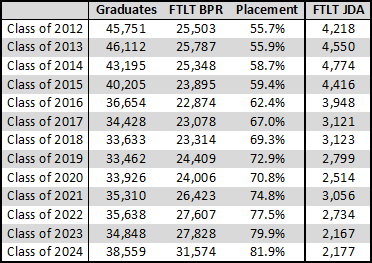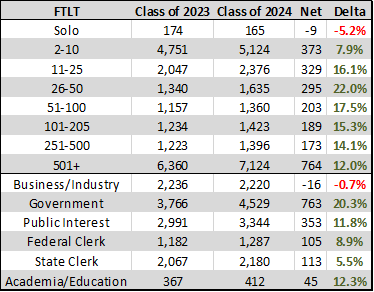Overall legal employment for the Class of 2024 improves slightly, with large law firm and public interest placement growing
The best employment year for recent law school graduates in at least the last decade
It is the same headline I had in 2023 and in 2022, but it’s another year of incremental improvement. Outcomes improved once again, and this despite law schools graduating thousands more students than in recent years. Below are figures for the ABA-disclosed data (excluding Puerto Rico’s three law schools). These are ten-month figures from March 15, 2025 for the Class of 2024.
Placement continues to be very good. There was a remarkable increase of over three thousand full-time, long-term bar passage-required jobs year-over-year, and the graduating class size increased significantly. Those factors combined for a placement rate of 81.9%. J.D. advantage jobs held steady, entirely consistent with a hot law firm market.
It’s remarkable to compare the placement rates from the Class of 2012 to the present, from 56% to 80%. And while a lot of that is attributable to the decline in class size, this year’s employment figures were extremely robust.
Here’s some comparison of the year-over-year categories (all full-time, long-term positions).
The trend continues a longstanding uptick in public interest placement, which is not an outlier and shows some of the fastest growth in the last decade. Public interest job placement is up over 100% since the Class of 2018. These eye-popping number continue to rise.
It is not an understatement to say that law students are increasingly oriented toward public interest, and that there are ample funding opportunities in public interest work to sustain these graduates. (I include a visualization of the trend of raw placement into these jobs here.)
Sole practitioners continue to remain low, as do “academia” or “education” positions (which typically thrive in a poor economy when schools hire their own graduates at higher rates). One slightly interesting observation is a continuing decline in “business” placement. These tend to be JD advantage positions, and if there’s a decline in JD advantage placement we’d expect to see a decline here, too, but it seems more significant than just JD advantage jobs.
Additionally, large law firm placement continues to boom. Placement is up more than thousands graduates in the last several years. Placement in firms with at least 101 attorneys is nearly 10,000. (While others have narrower definitions of “Big Law,” I think 101+ captures the bulk of elite placement, whether at the highest end or at higher-end regional firms.) More than 25% of all law school graduates landed in a “Big Law” firm, and more than 30% of those who were employed in a full-time, long-term, bar passage-required job landed in a “Big Law” firm.
(A chart showing both the raw placement and the percentage of graduates are included here in another visualization, charting both on two different axes to see similar trends and increases.)
How did law schools and law firms survive the purported “death of Big Law”? Well, Big Law seems to be doing better than ever. It’s not clear we’ll have as hot a market for this year’s class, but it’s something to watch.
Federal clerkship placement improved materially and is near recent highs.
One more note: what government hiring freeze? Yes, there was an ostensible federal government “hiring freeze,” and I wondered whether it would affect this year’s graduates—recent hires laid off, things like that. But overall government placed improved, materially, in the last year. Yes, that includes both federal and state government hiring, so it confounds the analysis somewhat. But it’s a small sign that the “freeze,” whatever it is, did not affect recent graduates as much as one might have feared.







